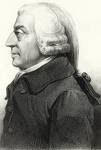 In the field of economics one of the arguments that gets thrown around rather loosely is the idea that Adam Smith, the patron saint of modern capitalism, was a big proponent of allowing individual market players do as they please. Proponents of this perspective tell us that allowing market players to operate freely in markets is what Adam Smith believed would create harmoney and the greater good. It's the keystone behind Smith's book The Wealth of Nations, so we are told.
In the field of economics one of the arguments that gets thrown around rather loosely is the idea that Adam Smith, the patron saint of modern capitalism, was a big proponent of allowing individual market players do as they please. Proponents of this perspective tell us that allowing market players to operate freely in markets is what Adam Smith believed would create harmoney and the greater good. It's the keystone behind Smith's book The Wealth of Nations, so we are told.Indeed, as Gavin Kennedy - author of Adam Smith: A Moral Philosopher and His Political Economy (Great Thinkers in Economics) - reminds us in his blog, we're usually treated to the following interpretation of Adam Smith:
Adam Smith first coined the term “The Invisible Hand” in his important book “The Wealth of Nations.” With this term he was trying to capture the idea that the marketplace would be self-regulating. The basic principle of the invisible hand is that though we may be unaware of it, an unseen hand is constantly prodding us along to act in line with what’s best for the whole economy. This means that when this invisible hand exists, when we all pursue our own interest, we end up promoting the public good ...This interpretation of Adam Smith misses why he used the "invisible hand" to convey a message about markets, and what capitalism's intellectual godfather actually said about the negative affects of markets.
As Gavin Kennedy points out here, Adam Smith made reference to the "invisible hand" because he was trying to help those who did not understand science and philosophy interpret how markets might work if market players played by the rules (which I discuss with reference to the "laws of nature" in my book).
More to the point, in "Adam Smith and the Invisible Hand: from metaphor to myth" Kennedy makes it clear that because Smith wanted to reach the "[s]avages and heathens who did not understand the science of nature" he "relied on notions of ‘invisible beings’ with ‘invisible hands’ to explain unusual phenomena." Smith did this because we were a superstitious and religious lot back in the late 18th century, and could only understand difficult concepts with the help of spiritual or supernatural references.
Put more simply - and I find this rather interesting - by using the "invisible hand" as a metaphor Adam Smith was trying to explain a difficult concept to the unlearned. In this way, according to Kennedy, the "invisible hand" was used as an "innocuous metaphor" en passant (a chess move), and not as a broad theoretical claim about markets and market players if the state would only leave them alone.
There's a difference between metaphor and theory, and is one of the reasons I wrote my book. Check out Kennedy's piece.
- Mark
No comments:
Post a Comment